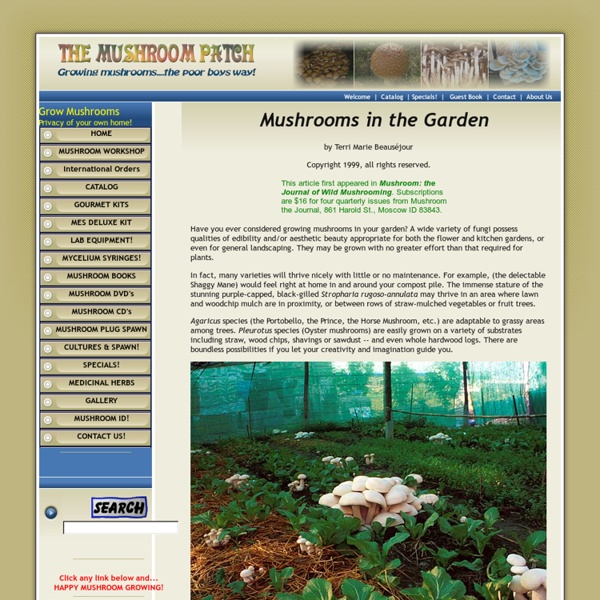Mushroom Garden Patches

10 Cheap Gardening Methods To Food Independence
Alex Pietrowski, Staff WriterWaking Times The issue of food quality and food independence is of critical importance these days, and people are recognizing just how easy and fun it is to grow your own food at home. When renegade gardener Ron Finley said, “growing your own food is like printing money,” he was remarking on the revolutionary nature of re-establishing control over your health and your pocket book as a means of subverting the exploitative and unhealthy food systems that encourage the over-consumption of processed and fast foods. Thanks to the internet, the availability of parts and materials, and good old-fashioned ingenuity, there is a wide range of in-home, and in-apartment, gardening systems that are easy to construct and maintain, and that can provide nutritious, organic, and low-cost food for you and your family. Aquaponics Read: Aquaponic Gardening: A Step-By-Step Guide to Raising Vegetables and Fish Together Vertical Gardening Simple Greenhouse Designs Composting
Grow Your Own Truffles
You don’t have to send cash to unfriendly foreign countries to enjoy black truffles anymore; this pungent and precious fungi is now being grown right here in good ole’ redneck North Carolina. WARNING! Despite the grandiose claims by Garland Truffles that it’s reasonable to make $25,000 per acre growing truffles, there are many well-documented failures. Our bottom line was that while there is a promise of $25k/acre yield, and daily hand-weeding and care for the years preceding the harvest can easily eat-up the profits . . . The State of North Carolina department of Agriculture did a $250,000 truffle grant in 2003 and the results for the foirst truffle harvest will be available in 2009. See my updated truffle notes here, and DO NOT pay for a visit to Garland Truffles (they charged me over $1,000 for my group) until you have checked the NC State data from their truffle grants. “The optimal site for a truffle orchard is an open area with good southern exposure. Scout, the hungry pony
How To Grow Mushrooms
The Process for growing mushrooms is pretty easy. But it does vary depending on the type of mushroom you are growing. With this tutorial I will show you a typical and easy way to grow Pearl Oyster Mushrooms (Pleurotus ostreatus). You Will need: Some kind of bucket or container - Typically a 5 gallon plastic pail is used. The picture below shows my materials. If it is going to take a while to collect up your coffee grounds you can store them in the freezer so they won't get moldy. Fill your bucket about halfway with coffee grounds. There can be more and I will show you why in a minute. If your coffee grounds are dry you should add some water at this point and let the water drain out. Now break up the mushroom spawn and add it to your bucket. If you have enough spore and coffee grounds fill the bucket up to within an inch of the top. This prevents carbon dioxide from building up on the surface. Cover your bucket with clear plastic and perforate it with a few holes. RESOURCES and MORE
Related:



